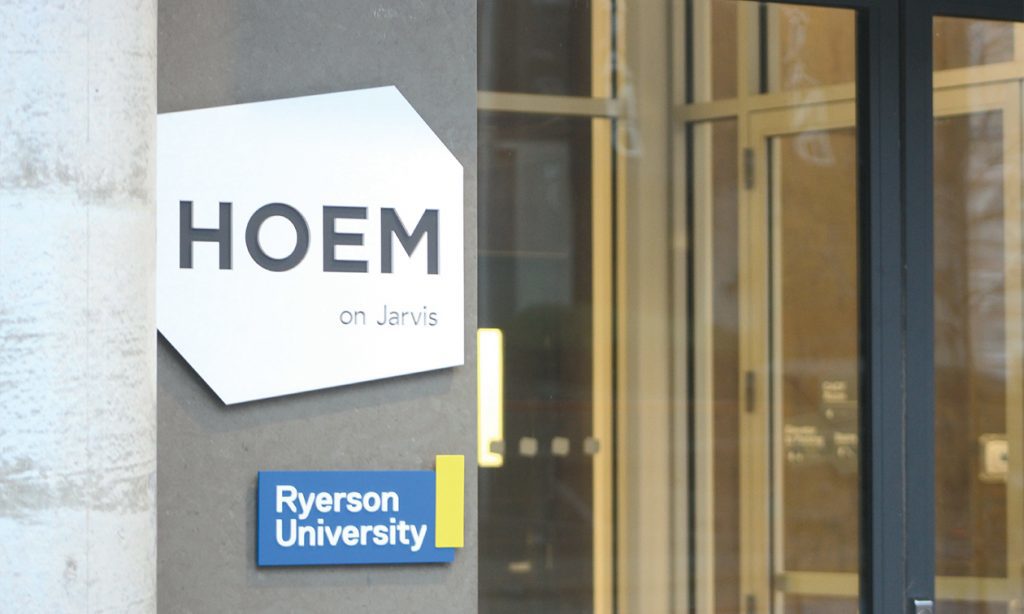By Ryan Moore and Declan Keogh
Ryerson is remaining tight-lipped on details surrounding an alleged sexual assault at HOEM — the school’s newest residence — and students want to know more.
“It’s a huge thing that has happened,” said Drishti Sherma, adding it’s something she and her roommates have taken very seriously. “We would like to know who it was, why it happened and why the security is so low in this residence building.”
Sherma, a second-year psychology student, also wants Ryerson to tell students if the suspect lives in the building, or if they were a guest. Before the incident, Sherma said they would rarely lock their doors — now, they do. “We are scared that it might happen to us one day.”
Besides releasing more information, Sherma wants to see the building become more secure. She said that the guest sign-in sheet is rarely kept up-to-date, meaning that keeping track of which guests have and have not left the building is difficult.
HOEM administrators referred the Ryersonian’s questions back to the university’s public affairs department who stated, “the only information we can provide at this time is that a Ryerson community member was at HOEM when an individual sexually assaulted them.”
Whether it was a student or someone from the outside is still unclear. All students entering the residence must present an access card and any other guest has to be signed in.

The security alert for the most recent sexual assault, issued to the community on Nov. 21, does not include many details. In a separate email obtained by the Ryersonian, Ian Crookshank, student vice-provost, told residents that their residence advisors would be discussing the incident.
However, Olimpiu Chis, a first-year mechanical engineering student, said that it didn’t come up at his floor meeting. Chis didn’t know about the assault until he spoke with the Ryersonian. He said that it would be helpful if there were posters around the building, because he often ignores security incident emails.
Chis also said he wasn’t sure if it would be a good thing to release more information because it could “also just bring a lot more of a negative impact on the residents in general.”
Jennifer Petryk, a first-year health and safety student, said that it’s the “right” of residents to know the details of the alleged sexual assault. “It’s important to be aware who’s in my residence and who’s in my living quarters,” she said.
The prospect of it being a fellow student is daunting, she said.
“It’s sort of scary to think that someone who could be harming me is so close to me…I sleep here, I live here, I do everything here,” she said. “I want to know for my safety — but I also don’t want to know because it’s scary.”
The front desk is located at the entrance to HOEM and is staffed 24/7, similar to Pitman Hall and the International Living/Learning Centre. However, the student residence is staffed by G4S, a private security company, from midnight to 8 a.m — when the sexual assault occurred. The international security firm did not respond to a request for comment in time for publication.
Ryerson security said they are still gathering information on the suspect. They declined to say why a description was not issued in the security alert.
It’s also unclear if there are security cameras in different areas of the building. Fitch Security Integration Inc. is another company who contracts its technology to the residence.
“Unfortunately and obviously we do not and cannot comment on any security system(s) we may have anywhere for any of our clients at any time,” said Ed Fitchett, Fitch Security president.
“I am sure you understand the massive breach of security this would be if we did so.”
Sexual violence represents 24 per cent of security alerts over the past four years, which, after the most recent events, is part of a 175 per cent increase in security alerts since 2015, according to Ryerson security data analyzed by the Ryersonian.
The security alert stated that the victim declined Toronto Police Service assistance “at the time,” but whether police have since been notified is another question public affairs did not answer.
Toronto police 51 division says they do not have any reports on the sexual assault at HOEM.
President Mohamed Lachemi gave the Ryersonian the same answers as did the public affairs department
“We are working with the management there, to see what the best way forward is to keep students safe,” he said.
Security first refers community members to the Consent Comes First (CCF) office after an incident of sexual assault, he said.
In the past year CCF, an on-campus resource that supports victims of sexual violence, has been accessed by 150 community members.
In the 2016-2017 academic year, the office received 80 visits, according to CCF.
“And then survivors of sexual violence may access Ryerson’s office of sexual violence for education on a variety of pathways,” said Lachemi, who reiterated that victims have different avenues of support that suits their individual needs best.
This is a joint byline.
Ryersonian staff are responsible for the news website edited and produced by final-year undergraduate and graduate journalism students at Ryerson University.
It features all the content from the weekly campus newspaper, The Ryersonian, and distributes news and online multimedia, including video newscasts from RyersonianTV.
Ryersonian.ca also provides videos, images, and other interactive material in partnership with the School of Journalism.

